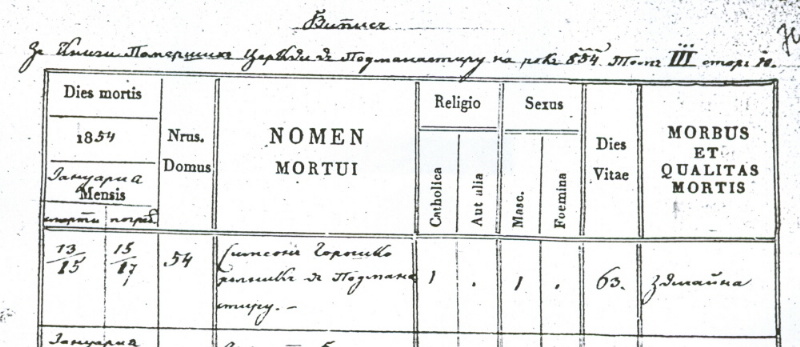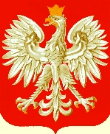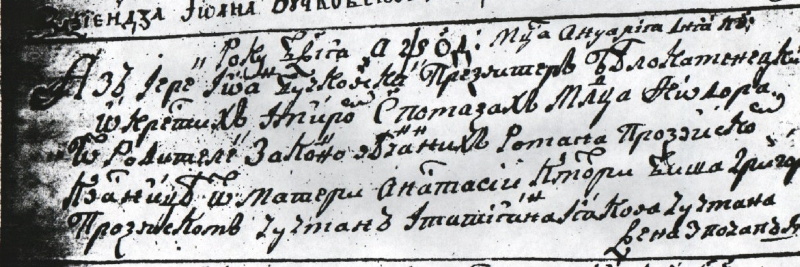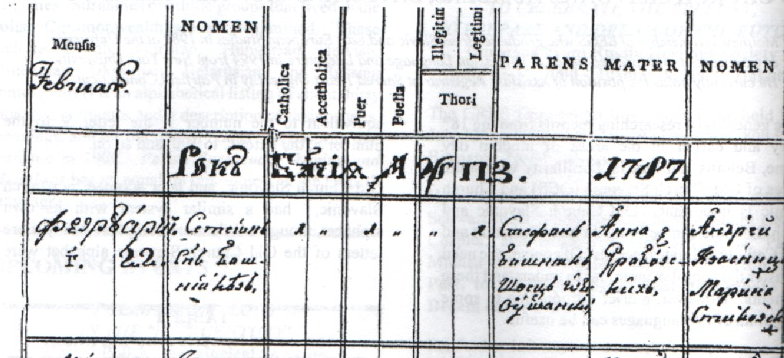Vital Records Tour -
| |||||||||||||||||||||||||||||||||||||||||||||||||||||||||||||||||||||||||||||||||||||||||||||||||||||||||||||||||||||||||||||||||||||||||||||||||||||||||||||||||||||||||||||||||||||||||||||||||||||||||||||||||||||||||||||||||||||||||||||||||||||||
|
Mensis Februar |
Nomen | Catholica | Accatholica | Puer | Puella | Illegitimi | Legitimi | Parens | Mater | Nomen | |
| Thori | |||||||||||
| Roku Bzhiia 1787. 1787 | |||||||||||
| Fevruarii 3 |
22 | Semeon" sn" Boshniakiv" |
√ | √ | √ | Stefan" Boshniak shvets" Ob. Ushanski |
Anna Grabovskykh" |
Andrei Kvasnyts + Maryna Stykovska + |
|||
Translation |
|||||||||||
| Month (Date) | (House No.) | Name | Catholic | Non-Catholic | Boy | Girl | Illegitimate | Legitimate | Parent | Mother | (Godparents') Names |
| Status | |||||||||||
| Year of the Lord 1787. 1787 | |||||||||||
| February 3 | 22 | Semen son of Boshniaks |
√ | √ | √ | Stefan Boshniak shoemaker resident of Ushnia |
Anna (of the) Grabovsky's | Andrei Kvasnyts
+ Maryna Stykovska + |
|||
Standard Latin Column Format
According to the rules and regulations of record keeping in the Austrian Empire, vital records were to be recorded in the Latin language, the lingua franca of the Catholic Church. You'll also find quite a bit of Polish, which was the predominate administrative and educational language of the region. However, you can also find some Ukrainian in the Greek Catholic records, a sign of the growing nationalism. The educated Greek Catholic clergy was the main strength behind the Ukrainian national movement of the middle to late 19th Century.
Although only a minority of the records will include Ukrainian, I strongly urge anyone researching Ukrainian and/or Greek Catholic roots to at least be familiar with the Cyrillic alphabet, in which the Ukrainian language has historically been written. (There was a short-lived movement by Polish and polonized Ukrainian scholars to adopt the Polish orthography/spelling rules to the Ukrainian language. But the Ukrainian language had been using some form of the Cyrillic alphabet as far back as the 10th Century!)
In some cases, the Greek Catholic priest included the Ukrainian first name along with the Latin. (Click on the image to view the entire page.)
from the village of Cheremoshnia, Greek Catholic parish of Bilyi Kamin, 1891.
In some cases, the entire record was recorded in Cyrillic, in either Ukrainian and/or a mix of Ukrainian, Russian and Church Slavic. Here are samples of a birth, marriage and death record in Ukrainian.
Each of these records come from the village of Budkiv, the Greek Catholic parish of Pidmanastyr (Podmanastyr).
Birth / Baptism

Extract <here "Copy" as in "Bishop's Copy">
From the Book of Births from the <Greek Catholic> church of the village of Budkiv for the year 1854, Volume II, page 58.
| Date | House Number | Name | Religion | Sex | Status | Parents | Godparents | |||
| of Birth | of Baptism | Catholic | Boy | Name | Occupation | Name | Occupation | |||
| Іануарій 13/25 |
Іануарій 13/25 | 42 | Павло | √ | √ | правил | Феодоръ Застадній й Варвара Петра й Ксеній Копитко ролниковъ зъ Будковa дочкa. | Ролники въ Будковђ. | Іацко Каніуко Агафђа Николая Котетка жена |
Ролнікі въ Будковђ |
| Januarii 13/25 |
Januarii 13/25 |
42 | Pavlo | √ | √ | pravyl. | Feodor Zastadnii i Varvara Petra i Ksenii Kopytko rolnikov z Budkova dochka. | Rolniki v Budkove. | Iatsko Kaniuko Ahafea Nykolaia Kotetka zhena |
Rolniki v Budkove |
| January 13/25 |
January 13/25 |
42 | Pavlo | √ | √ | legal (legitimate) | Feodor Zastadnii and Varvara daughter of Petro and Ksenia Kopytko, farmers from Budkiv. | Farmers in Budkiv. | Iatsko Kaniuko Ahafea Kotetka, wife of Nykolai |
Farmers in Budkiv |
Marriage

from the Book of Marriages of the <Greek Catholic> Budkiv church, Volume I, page 53 for the solar year 1853
| Date | Groom | Bride | Witnesses | ||||||||
| House No. | Name | Catholic | Age | Widower | Name | Catholic | Age | Single | Name | Occupation | |
| 27 Іан. 8 Лут. 1853 |
56 | Филипъ Зaкунъ синъ Пaвлa й Пaрaскевій Закунъ ролниковъ зъ Будковa | √ | 44 | √ | Анaстaзия Пердaлa, дочкa Вaсилия и Евки Пердaловъ, ролниковъ зъ Будковa. | √ | 42 | √ | Вaсилій Пердала Василій Кіернђцкій |
Ролніке зъ Будковa зъ Підманастира |
| 27 Ian. 8 Lut. 1853 |
56 | Fylyp Zakun syn Pavla i Paraskevii Zakun rolnikov z Budkova | √ | 44 | √ | Anastazyia Perdala, dochka Vasylyia i Evky Perdalov, rolnykov z Budkova. | √ | 42 | √ | Vasylii Perdala Vasylii Kiernetskii |
Rolnike z Budkova z Pidmanastyra |
| 27 Jan. 8 Feb 1853 |
56 | Fylyp Zakun son of Pavlo and Paraskevia Zakun, farmers from Budkiv | √ | 44 | √ | Anastazyia Perdala, daughter of Vasylii and Evka Perdala, farmers from Budkiv | √ | 42 | √ | Vasylii Perdala Vasylii Kiernetskii |
Farmers from Budkiv from Pidmanastyr |
Death

Extract <here Copy, as in "bishop's copy">
From the Book of Deaths of the <Greek Catholic> church in Podmanastyr <Pidmanastyr> for the year 1854, Volume III, page 10.
|
Date of death |
House No. |
Name of deceased |
Religion |
Sex |
Age |
Cause of Death |
|
|
January |
|||||||
| смерти 13/15 |
погроб. 15/17 |
54 | Симеонъ Горошко ролникъ въ Подмaнaстиру. | 63 | Звичaйнa | ||
| smerty 13/15 |
pohrob. 15/17 |
Symeon Horoshko, rolnyk v Podmanastyru | Zvychaina | ||||
| of death 13/15 |
of burial 15/17 |
Symeon Horoshko, farmer in Podmanastyr <Pidmanastyr> | Usual | ||||
|
www.halgal.com
Questions and Comments to Matthew
Bielawa |





